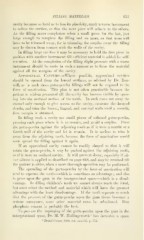Page 673 - My FlipBook
P. 673
FILLISG MATERIALS. 671
cavity becomes so hard as to lose its plasticity, apply a warm instrument
to soften the surface, so that the next piece will adhere to the others.
As the filling nears completion select a small piece for the last, just
large enough to complete the filling and no more, so that none will
have to be trimmed away, for in trimming the surplus away the filling
may be drawn from contact with the walls of the cavity.
In filling large cavities it may be necessary to hold the first piece in
position with another instrument till sufficient material is added for self-
retention. At the completion of the filling slight pressure with a warm
instrument should be made in such a manner as to force the material
against all the margins of the cavity.
Appeoximal Cavities,—Where possible, approximal cavities
should be opened from the buccal surfaces, as advised by Dr. Bon-
will, as in such cases gutta-percha fillings will not be exposed to the
force of mastication. This plan is not often practicable because the
patient is seldom presented till the cavity has become visible by open-
ing into the occlusal surface of the tooth. In such cases cut away the
enamel only enough to give access to the cavity, excavate the decayed
dentin, and trim the buccal, lingual, and cervical walls until a smooth,
firm margin is obtained.
In filling such a cavity use small pieces of softened gutta-percha,
pressing each piece where it is to remain, and avoid a surplus. Press
the gutta-percha against the adjoining tooth as if it were a matrix or a
fourth wall of the cavity and let it remain. It is useless to trim it
away from the adjoining tooth, because the force of mastication would
soon spread the filling against it again.
If an approximal cavity cannot be readily shaped so that it will
retain the gutta-percha, it may be packed against the adjoining tooth,
as if it were an occlusal cavity. It will prevent decay, especially if sil-
ver nitrate is applied as described on page 668, and may be retained till
the patient is older, when a more thorough operation may be performed.
The spreading of the gutta-percha by the force of mastication will
tend to separate the teeth—which is sometimes an advantage ; and also
to press upon the gum in the interproximal space—which is a disad-
vantage. In filling children's teeth we cannot always reach the ideal,
but must select the method and material which will have the greatest
advantage Avith the least disadvantage. If the teeth separate so much
that the pressure of the gutta-percha upon the gum tissue becomes a
serious annoyance, some other material must be substituted. Zinc
phosphate cement is probably the best.
To prevent the impinging of the gutta-percha upon the gum in the
interproximal space, Dr. M. W. Hollingsworth ^ has invented a space
^ Dental Cosmos, 1S96, vol. xxxviii. p. 553.


